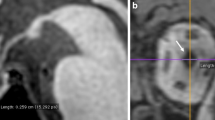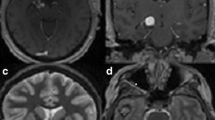Abstract
Purpose
Antero-inferior temporal lobe meningoencephaloceles are a rare, but increasingly recognized cause of drug-resistant temporal lobe epilepsy (TLE). In order to evaluate whether these lesions are related to idiopathic intracranial hypertension (IIH), we analyzed clinical and MRI findings of a cohort of patients undergoing presurgical work-up.
Methods
Seizure onset in the anterior temporal lobe was proven by EEG electrodes in 22 patients, and in 21 patients, anterior temporal lobectomy (mostly with sparing of the hippocampus) was performed. MRI signs of IIH (in particular empty sella) and the volumes of the ventricles and external CSF spaces were determined and related to the body mass index (BMI) and clinical outcome.
Results
Six of seven obese (BMI > 30 kg/m2) compared to four of 15 non-obese patients had partial empty or empty sella (p = 0.007). Bilateral lesions were found in all obese and 11 patients. Seizure freedom (Engel class 1A) was achieved in 12 of 21 patients (5 obese compared to 7 non-obese patients). BMI was related to the volume of the external CSF spaces (r = 0.467), and age at seizure onset was higher in obese patients.
Conclusion
Roughly a third of patients with temporal lobe epilepsy due to antero-inferior meningoencephaloceles is obese and has MRI signs of idiopathic intracranial hypertension.






Similar content being viewed by others
Abbreviations
- BMI:
-
Body mass index
- TLE:
-
Temporal lobe epilepsy
- IIH:
-
Idiopathic intracranial hypertension
References
Ruiz GF (1971) A case of temporal lobe epilepsy caused by an encephalocele. Rev Esp Otoneurooftalmol Neurocir 170:216–220
Hyson M, Andermann F, Olivier A et al (1984) Occult encephaloceles and temporal lobe epilepsy: developmental and acquired lesions in the middle fossa. Neurology 34:363–366
Whiting DM (1990) Intractable complex partial seizures associated with occult temporal lobe encephalocele and meningoangiomatosis: a case report. Surg Neurol 34:318–322
Leblanc R, Tampieri D, Robitaille Y et al (1991) Developmental anterobasal temporal encephalocele and temporal lobe epilepsy. J Neurosurg 74:933–939
Wilkins RH, Radtke RA, Burger PC (1993) Spontaneous temporal encephalocele. Case report. J Neurosurg 78:492–498
Mulcahy MM, McMenomey SO, Talbot JM et al (1997) Congenital encephalocele of the medial skull base. Laryngoscope 107:910–914
Shafa B, Arle J, Kotapka M (1999) Unusual presentation of middle fossa encephaloceles: report of two cases. Skull Base Surg 9:289–294
Abou-Hamden A, Lau M, Fabinyi G et al (2010) Small temporal pole encephaloceles: a treatable cause of “lesion negative” temporal lobe epilepsy. Epilepsia 51:2199–2002
Yang E, Yeo SB, Tan TY (2004) Temporal lobe encephalocele presenting with seizures and hearing loss. Singap Med J 45:40–42
Narasimhan K, Coticchia J (2006) Transsphenoidal encephalocele in a neonate. Ear Nose Throat J 85:420–422
Vargas MI, Vulliemoz S, Rosset A et al (2008) Temporal anterior encephalocele. Neurology 71:1293
Wind JJ, Caputy AJ, Roberti F (2008) Spontaneous encephaloceles of the temporal lobe. Neurosurg Focus 25:E11
Byrne RW, Smith AP, Roh D et al (2010) Occult middle fossa encephaloceles in patients with temporal lobe epilepsy. World Neurosurg 73:541–546
Faulkner HJ, Sandeman DR, Love S et al (2010) Epilepsy surgery for refractory epilepsy due to encephalocele: a case report and review of the literature. Epileptic Disord 12:160–166
Aquilina K, Clarke DF, Wheless JW et al (2010) Microencephaloceles: another dual pathology of intractable temporal lobe epilepsy in childhood. J Neurosurg Pediatr 5:360–364
Connor SE (2010) Imaging of skull-base cephalocoele and cerebrospinal fluid leaks. Clin Radiol 65:832–841
Bendersky DC, Landriel FA, Ajler PM et al (2011) Sternberg’s canal as a cause of encephalocele within the lateral recess of the sphenoid sinus: a report of two cases. Surg Neurol Int 2:171
Brainard L, Chen DA, Aziz KM et al (2012) Association of benign intracranial hypertension and spontaneous encephalocele with cerebrospinal fluid leak. Otol Neurotol 33:1621–1624
Giulioni M, Marucci G, Martioni M et al (2013) Seizure outcome in surgically treated drug-resistant mesial temporal lobe epilepsy based on the recent histopathological classifications. J Neurosurg 119:37–47
Giulioni M, Licchetta L, Bisulli F et al (2014) Tailored surgery for drug-resistant epilepsy due to temporal pole encephalocele and microdysgenesis. Seizure 23:164–166
Gasparini S, Ferlazzo E, Villani F et al (2014) Refractory epilepsy and encephalocele: lesionectomy or tailored surgery? Seizure 23:583–584
Morone PJ, Sweeney AD, Carlson ML et al (2015) Temporal lobe encephaloceles: a potentially curable cause of seizures. Otol Neurotol 36:1439–1442
Shimada S, Kunii N, Kawai K et al (2015) Spontaneous temporal pole encephalocele presenting with epilepsy: report of two cases. World Neurosurg 84:867.e1–867.e6
Van Gompel JJ, Miller JW (2015) How epileptogenic are temporal encephaloceles? Neurology 85:1440–1441
Chang RO, Marshall BK, Yahyavi N et al (2016) Neuroimaging features of idiopathic intracranial hypertension persist after resolution of papilloedema. Neuroophthalmology 40:165–170
Darouassi Y, Mliha Touati M, Chihani M et al (2016) Spontaneous cerebrospinal fluid leak of the sphenoid sinus mimicking allergic rhinitis, and managed successfully by a ventriculoperitoneal shunt: a case report. J Med Case Rep 10:308
Aaron GP, Illing E, Lambertsen Z et al (2017) Enlargement of Meckel’s cave in patients with spontaneous cerebrospinal fluid leaks. Int Forum Allergy Rhinol 7:421–424
Saavalainen T, Jutila L, Mervaala E et al (2015) Temporal anteroinferior encephalocele: an underrecognized etiology of temporal lobe epilepsy? Neurology 27(85):1467–1474
Panov F, Li Y, Chang EF et al (2016) Epilepsy with temporal encephalocele: characteristics of electrocorticography and surgical outcome. Epilepsia 57:e33–e38
Toledano R, Jimenze-Huete A, Campo P et al (2016) Small temporal pole encephalocele: a hidden cause of “normal” MRI temporal lobe epilepsy. Epilepsia 57:841–851
Dias LA, Nakanishi M, Mangussi-Gomes J et al (2014) Successful endoscopic endonasal management of a transclival cerebrospinal fluid fistula secondary to ecchordosis physaliphora—an ectopic remnant of primitive notochord tissue in the clivus. Clin Neurol Neurosurg 117:116–119
Alsonso RC, de la Peña MJ, Caicoya AG et al (2013) Spontaneous skull base meningoencephaloceles and cerebrospinal fluid fistulas. Radiographics 33:553–570
Schuknecht B, Simmen D, Briner HR et al (2008) Nontraumatic skull base defects with spontaneous CSF rhinorrhea and arachnoid herniation: imaging findings and correlation with endoscopic sinus surgery in 27 patients. AJNR Am J Neuroradiol 29:542–549
Stucken EZ, Selesnick SH, Brown KD (2012) The role of obesity in spontaneous temporal bone encephaloceles and CSF leak. Otol Neurotol 33:1412–1417
Carlson ML, Copeland WR 3rd, Driscoll CL et al (2013) Temporal bone encephalocele and cerebrospinal fluid fistula repair utilizing the middle cranial fossa or combined mastoid-middle cranial fossa approach. J Neurosurg 119:1314–1322
Settecase F, Harnsberger HR, Michel MA et al (2014) Spontaneous lateral sphenoid cephaloceles. Anatomic factors contributing to pathogenesis and proposed classification. AJNR Am J Neuroradiol 35:784–789
Friedman DI, Liu GT, Digre KB (2013) Revised diagnostic criteria for the pseudotumor cerebri syndrome in adults and children. Neurology 81:1159–1165
Degnan AJ, Levy LM (2011) Pseudotumor cerebri: brief review of clinical syndrome and imaging findings. AJNR Am J Neuroradiol 32:1986–1993
Markey KA, Mollan SP, Jensen RH et al (2016) Understanding idiopathic intracranial hypertension: mechanisms, management, and future directions. Lancet Neurol 15:78–91
Kral T, Clusmann H, Urbach H et al (2002) Preoperative evaluation for epilepsy surgery (Bonn Algorithm). Zentralbl Neurochir 63:106–110
Schulze-Bonhage A, Zentner J (2014) The preoperative evaluation and surgical treatment of epilepsy. Dtsch Arztebl Int 111:313–319
Wellmer J, Quesada CM, Rothe L et al (2013) Proposal for a magnetic resonance imaging protocol for the detection of epileptogenic lesions at early outpatient stages. Epilepsia 54:1977–1987
Urbach H, Mast H, Egger K et al (2015) Presurgical MR imaging in epilepsy. Clin Neuroradiol 25(Suppl 2):151–155
Ashburner J, Friston KJ (2005) Unified segmentation. NeuroImage 26:839–851
Engel J Jr, Van Ness PC, Rasmussen TB et al (1993) Outcome with respect to epileptic seizures. In: Engel J Jr (ed) Surgical Treatment of the Epilepsies. Raven Press, New York, pp 609–621
Garcıa-Uria J, Ley L, Parajon A et al (1999) Spontaneous cerebrospinal fluid fistulae associated with empty sellae: surgical treatment and long-term results. Neurosurgery 45:766–773
Author information
Authors and Affiliations
Corresponding author
Ethics declarations
Funding
No funding was received for this study.
Conflict of interest
The authors declare that they have no conflict of interest.
Ethical approval
All procedures performed in the studies involving human participants were in accordance with the ethical standards of the institutional and/or national research committee and with the 1964 Helsinki Declaration and its later amendments or comparable ethical standards. For this type of study formal consent is not required.
Informed consent
For this type of retrospective study formal consent is not required.
Rights and permissions
About this article
Cite this article
Urbach, H., Jamneala, G., Mader, I. et al. Temporal lobe epilepsy due to meningoencephaloceles into the greater sphenoid wing: a consequence of idiopathic intracranial hypertension?. Neuroradiology 60, 51–60 (2018). https://doi.org/10.1007/s00234-017-1929-5
Received:
Accepted:
Published:
Issue Date:
DOI: https://doi.org/10.1007/s00234-017-1929-5




